Rune Q&A
We sit down and talk with lead designer Tim Gerritsen about this high fantasy action game.
Over the weekend, Gathering of Developers and Human Head Studios announced that development on Rune was recently completed, and that the third-person action game would soon be going into the final stages of production and distribution. Powered by Epic's powerful Unreal Tournament engine, Rune is a game steeped in Norse mythology, and it features an impressive hand-to-hand combat system that lets you wield a wide variety of distinctive melee weapons. We took this opportunity to talk to Rune's project manager, Tim Gerritsen, about the game's development cycle from start to finish, discuss the major obstacles Human Head encountered in making Rune, and reveal what the design team wished they could have added to the game but didn't have the chance to.
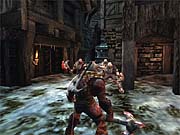
GameSpot: Briefly describe Rune and make sure to detail its plots and gameplay techniques.
Tim Gerritsen: Rune is a game about melee combat in the age of the Vikings, in a world where reality is closer to what the Vikings believed it to be - a fantastic world of fantastic creatures where the gods held sway.
You play a young Viking named Ragnar who is an Odinsblade - a defender of Odin and protector of his runestones on Midgard (Earth). You begin the game by going through your ritual of manhood, which is basically a test of your skills (and a chance to train a little). You hear of a group called the Dark Vikings, a group that has foresworn allegiance to Odin and has begun raiding and destroying local villages.
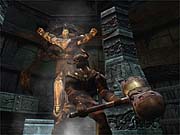
Your journey takes you through the fantastic places of Viking myth. You explore the depths of Muspelheim and Jotunheim as well as lands in Midgard. The game is based on the myths and lore of the Vikings, and as such, it provides a deep story that captures the excitement of the period in a game of epic adventure.
GS: Melee combat hasn't really been explored on the PC at the depth that Rune promises to deliver. Was the inspiration for the game based on a relative dearth of similar games?
TG: The inspiration came when Ted Halsted, one of the partners, sketched a Viking in one of the design meetings and came up with an early draft of an older version of Ragnar. He showed us the sketch and said, "Who the hell wouldn't want to play this guy?" It was hard to argue, as who wouldn't want to be a big Viking with lots of sharp objects to play with? The fact that there is really nothing else out there like it is a big bonus - and icing on the cake.
GS: How many weapons will be available in the single-player campaign? Which ones are your favorites?
TG: There are 15 weapons, five each of swords, bashing weapons, and axes. My favorite is probably the dwarven battle axe or the Viking broad sword. They rock.

GS: What about multiplayer? How different is it from the gameplay in the single-player component of Rune?
TG: Very. Single-player combat, especially against the Vikings, is a total blast, as they play very defensively. Multiplayer is very different, with a different tack. Most people go in whacking, which forces you to play differently because your opponent usually doesn't care so much if he gets whacked (our AIs have a greater sense of self-preservation than the average deathmatcher). Multiplayer has a whole host of different things going on.
GS: How many enhancements did you make to Epic's Unreal Tournament engine?
TG: Quite a few, really - some major, many minor. Our biggest change was to the animation system. Our system, which is skeletal, is a rotationally interpolated, fully hierarchical, point-weighted animation system. That's a mouthful, but what it means is that our characters look great when they animate, with none of the pinching or skipping that you see in older animation systems. Because we animate only bone data, the resulting file size is much smaller, which we took advantage of to create lots of new animations. We are really proud of the system, because it really looks good and has lead to us making a much more striking game than we could have otherwise.
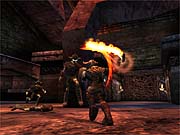
Other changes include a full shadowing system (scalable to your system speed), a particle animation and effects system, new melee-focused AI, and multiple changes to the Unreal Editor to allow us new scripting modes and cinematic camera control. Finally, we incorporated the latest changes to Direct3D support and multiplayer so that people who play our game will be able to really enjoy it. All in all, it was a major improvement to the already spectacular Unreal Tournament engine.
GS: Were there any aspects of the Unreal Tournament engine that proved to be a challenge for your programmers to overcome?
TG: Unreal Tournament is a very adaptable engine. Every engine has its own quirks that you have to accommodate, but I can't say there was one thing really giving us nightmares. We basically picked and chose what we wanted and changed what we didn't want. In the future, though, I don't think we will support such a wide range of video APIs. Supporting all the different APIs that Unreal supports is a major bear. We chose to concentrate on Direct3D, OpenGL, and GLide, but supporting MeTaL added complications, and we just plain had to throw out PowerVR support. In the future, I think we will pick one API or, at most, two.
GS: Rune has made appearances at the two previous E3s. What was the best piece of feedback you received during these shows?
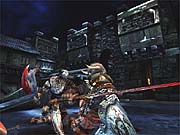
TG: There was one particular, very high-profile guy in the industry who came to see it at the latest E3, and he stated we were the best damn melee combat game he has ever seen. That was pretty cool. His publisher had been offered the title at one point, and he also stated, "Those [guys] could have had this title and they blew it." That was pretty cool too.
Several other people stated that they were blown away with how far we had gotten from the initial - admittedly limited - tech demo we showed at E3 in 1999. It was a major amount of work between the two shows, and it really came across.
GS: Was there anything you wanted to add to Rune that you weren't able to?
TG: I don't think it is possible to release a game without your always wanting to add one more thing, but there are a few things that we wanted to do and probably will do on our own in the following weeks and months. The biggest being more modes for multiplayer. We want to get some new forms of cooperative and competitive play in there for people to enjoy, like variations of capture-the-flag and assault mode.
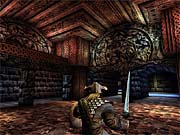
GS: Now that the game is complete, can you honestly say it came out exactly the way you originally envisioned it to be?
TG: To be honest, no, it does not match the original vision, but I don't think that is necessarily a bad thing. We had some fairly overly ambitious and other downright dumb ideas in the early stages that we tossed out later because they weren't workable. I think what we are releasing is actually, in many ways, better than what we had envisioned.
GS: Rune went gold over the weekend. When do you expect it to be on store shelves?
TG: It is slated to be on the shelves on October 30. It may be a few days earlier, but it sure won't be later than that.
GS: Thanks, Tim.
Got a news tip or want to contact us directly? Email news@gamespot.com
Join the conversation